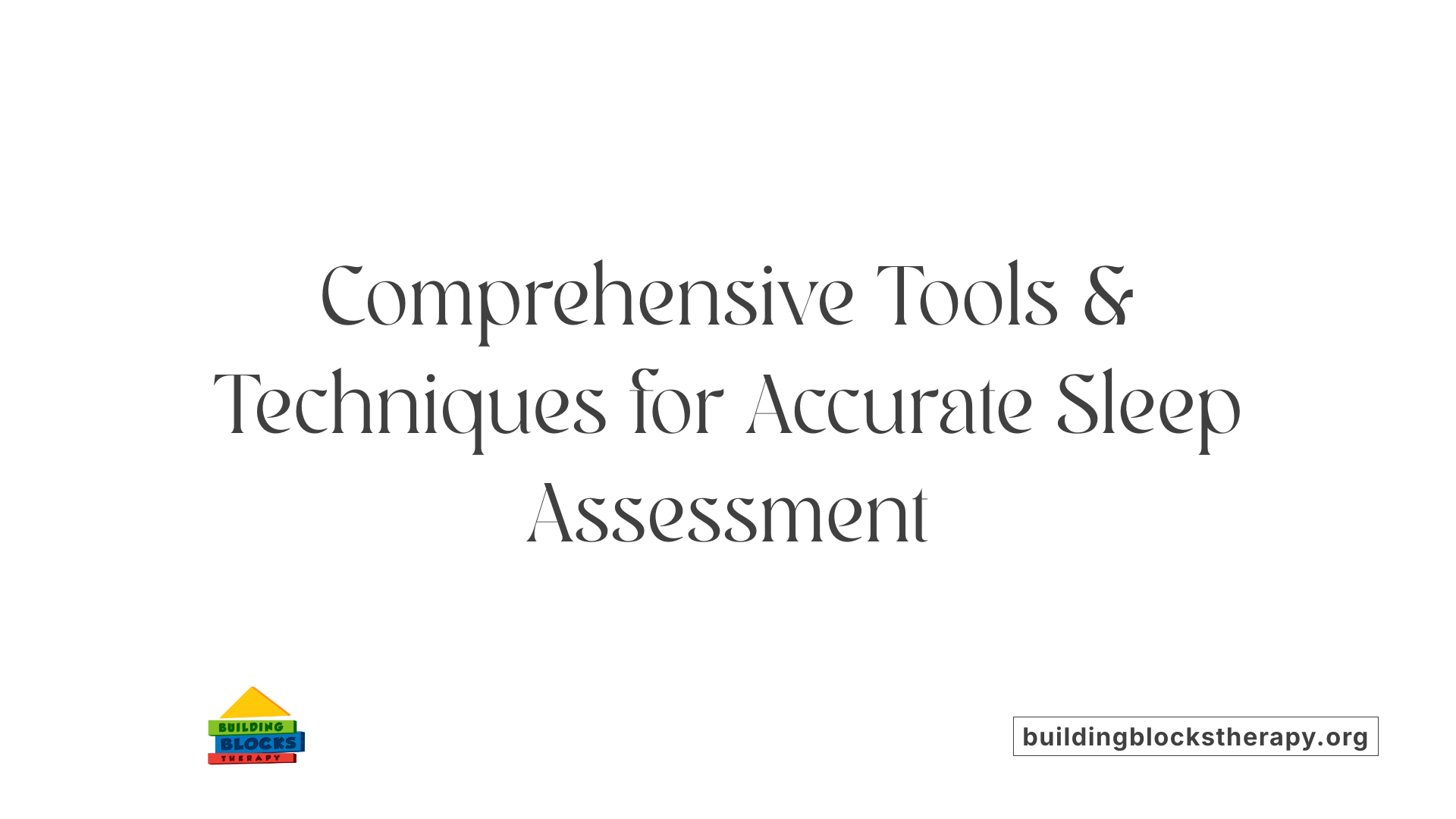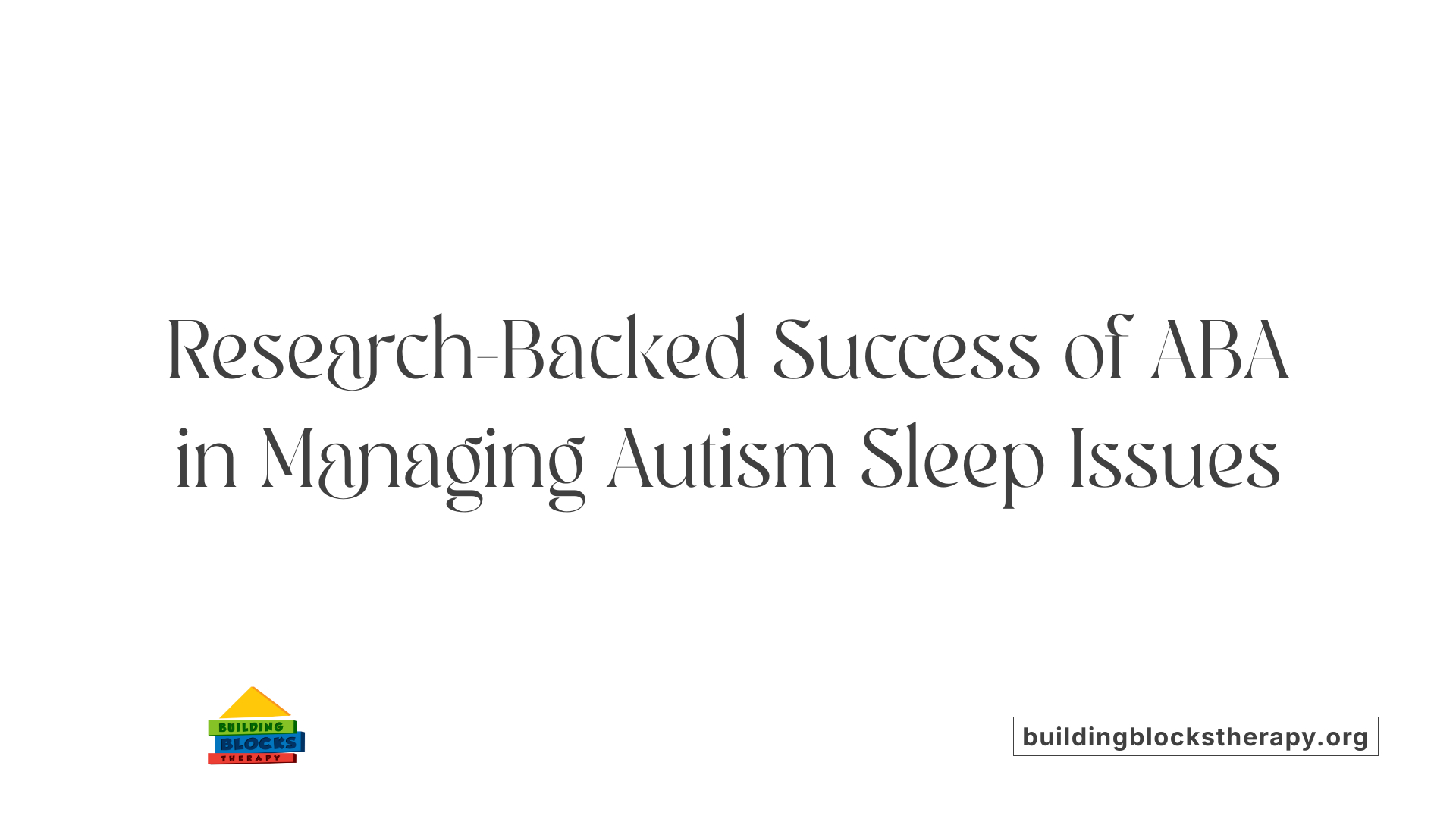ABA for Autism and Sleep Disorders
Sleep Solutions Tailored for Children with Autism

Understanding the Role of ABA in Managing Sleep Disorders
Sleep problems are highly prevalent among children with autism spectrum disorder (ASD), affecting up to 80% of this population. These issues not only compromise daytime functioning but can also exacerbate core ASD symptoms such as social communication difficulties and repetitive behaviors. Applied Behavior Analysis (ABA), a scientifically supported intervention, is increasingly used to address sleep disturbances in children with autism. This article explores how ABA techniques are applied, assessed, and supported by research to improve sleep quality in this vulnerable group.
Assessment of Sleep Problems in Children with Autism

How are sleep problems assessed in children with autism?
Evaluating sleep difficulties in children with autism requires a multifaceted approach that combines both subjective reports and objective measurements.
Parents and caregivers play a crucial role in this process. They often complete standardized questionnaires like the Children’s Sleep Habits Questionnaire (CSHQ) and keep detailed sleep diaries. These tools provide insights into sleep patterns, bedtimes, night awakenings, and behaviors that might interfere with restful sleep.
To gain more precise data, clinicians may use objective tools such as actigraphy. An actigraph is a wearable device that tracks movement patterns, helping estimate sleep duration and quality over multiple nights.
Polysomnography (PSG) is considered the most comprehensive assessment method, offering detailed information on sleep architecture, breathing, and neurological activity. However, due to its cost, complexity, and the potential difficulty for children with ASD to tolerate the procedure, PSG is usually reserved for cases where medical conditions like sleep apnea or seizures are suspected.
Other visual observation methods like videosomnography can also be helpful. This technique involves recording sleep behavior on camera, providing additional context for sleep disturbances.
Alongside these assessments, a thorough clinical history, including medical evaluations and discussions about possible underlying causes such as gastrointestinal issues, sensory sensitivities, or sleep-related medical conditions, is essential.
This comprehensive assessment guides clinicians in designing personalized interventions aimed at improving sleep quality.
| Assessment Tool | Description | Typical Use Case |
|---|---|---|
| Parent questionnaires | Examples include CSHQ and FISH | Initial screening and routine monitoring |
| Sleep diaries | Daily logs kept by parents or caregivers | Tracking sleep patterns over time |
| Actigraphy | Wearable movement monitors | Estimating sleep/wake cycles |
| Polysomnography | Detailed sleep studies (lab-based) | Diagnosing sleep disorders like apnea |
| Videosomnography | Video recordings of sleep behavior | Visual observation of sleep disturbances |
By combining these tools and methods, clinicians can accurately identify sleep problems in children with autism, facilitating effective and tailored treatment plans.
Understanding ABA Therapy in the Context of Autism and Sleep Disorders

What is ABA therapy and how does it help children with autism improve their sleep?
Applied Behavior Analysis (ABA) therapy is a scientifically grounded approach that utilizes behavioral techniques to teach new skills and reduce behaviors that hinder daily functioning in children with autism spectrum disorder (ASD). When it comes to sleep issues, ABA focuses on pinpointing behaviors that interfere with sleep, such as reluctance, bedtime resistance, or anxiety.
By collecting detailed sleep data through diaries and assessments, therapists can develop customized intervention plans. These plans often include establishing consistent bedtime routines, teaching self-soothing skills, and modifying environmental factors to promote better sleep. Techniques like bedtime fading, where the child's sleep schedule is gradually shifted to a more suitable time, and response cost, which involves reducing attention or reinforcement during troublesome behaviors, are commonly used.
Parental involvement is crucial. Therapists coach parents on reinforcing positive behaviors and applying strategies consistently at home. This collaboration ensures that behaviors learned during therapy are maintained and adapted to the child’s changing needs.
Studies show that behavioral interventions such as these not only improve sleep parameters like sleep onset latency and duration but also positively impact daytime behaviors. Children learn to fall asleep independently, wake less during the night, and show reduced sleep resistance.
Overall, ABA offers a safe, non-medical approach that directly targets the behavioral roots of sleep difficulties, leading to sustainably improved sleep habits and better overall functioning for children with autism.
Key Behavioral Techniques in ABA for Improving Sleep

What behavioral techniques within ABA are effective for improving sleep in children with autism?
Applied Behavior Analysis (ABA) offers several effective strategies to enhance sleep in children with autism. Central to these methods are stimulus control strategies like bedtime fading and routines. Bedtime fading involves gradually adjusting the child's bedtime to match when they naturally fall asleep, which increases sleep duration and reduces the time it takes to fall asleep.
Establishing positive routines also plays a vital role. Consistent bedtime routines involving calming activities help signal to the child that it is time to sleep, reducing anxiety and resistance. These routines might include reading a favorite book, listening to calming music, or using preferred objects in the sleep environment. Such practices reinforce sleep cues and promote relaxation.
Behavioral techniques such as extinction protocols are used to address night awakenings and sleep resistance. These involve refusing to reinforce behaviors like calling out or crying by calmly returning the child to bed without providing attention or reinforcement. This helps children learn to self-soothe and fall back asleep independently.
Additionally, visual schedules and sleep aids are employed to support consistent, predictable behaviors at bedtime. For example, a visual chart with pictures can guide children through the steps of their bedtime routine, reducing uncertainty and agitation.
When children wake during the night, parents are encouraged to respond in a calm, consistent manner—placing the child back in bed calmly and avoiding inadvertent reinforcement of wakefulness or escape behaviors. The use of comforting objects such as favorite blankets or stuffed animals further encourages independent sleep.
In summary, ABA interventions focus on creating a predictable and supportive sleep environment, reinforcing successful sleep behaviors through positive reinforcement, and carefully managing disruptions. These strategies aim to foster better sleep patterns, reduce bedtime struggles, and improve overall well-being for children with autism.
Scientific Evidence Supporting ABA-Based Sleep Interventions

What scientific evidence supports the use of ABA for treating sleep problems in children with autism?
Research consistently demonstrates that ABA (Applied Behavior Analysis) techniques are effective in addressing sleep disturbances in children with autism spectrum disorder (ASD). Several clinical studies and systematic reviews have evaluated the impact of behavioral interventions on sleep quality in this population.
A prominent meta-analysis, which pooled data from 14 randomized controlled trials involving 555 children, found strong evidence that ABA-based sleep interventions significantly improve sleep outcomes. These studies utilized various behavioral strategies such as establishing consistent bedtime routines, gradual bedtime fading, and positive reinforcement to encourage independent sleep.
Furthermore, the research highlights that interventions tailored to each child's specific needs—implemented within the familiar home environment—lead to more successful outcomes. Common techniques include sleep scheduling, environmental modifications, and parent training, all grounded in behavioral principles.
The effects of these interventions extend beyond sleep improvements. Many studies report reductions in problematic nighttime behaviors, less resistance at bedtime, and improved daytime functioning. Enhanced sleep not only helps children feel rested but also positively impacts their social and communication skills, which are core challenges in ASD.
While most evidence centers on sleep metrics like sleep onset latency and total sleep duration, the collateral benefits—such as decreased daytime behavioral problems—support the broader utility of ABA interventions. Importantly, evidence emphasizes the importance of involving parents actively in therapy to sustain progress.
| Study Type | Number of Trials | Sample Size | Main Findings | Additional Notes |
|---|---|---|---|---|
| RCTs | 14 | 555 children | Sleep quality and duration improved | Tailored behavioral techniques, home-based implementation |
| Systematic reviews | Multiple | Varies | Reinforces effectiveness and broader benefits | Highlights importance of parent involvement |
Overall, current scientific research affirms that ABA-based behavioral strategies are a robust approach for managing sleep disturbances in children with ASD, leading to meaningful and lasting improvements.
Integrating Behavioral Interventions into Sleep Management Plans
How are behavioral interventions integrated into sleep management plans for children with autism?
Home-based ABA therapy plays a vital role in improving sleep patterns among children with autism by customizing behavioral techniques to meet each child's unique needs. Initially, a thorough assessment is conducted, which includes collecting sleep data through diaries, questionnaires, and observations. These assessments help identify specific sleep issues like prolonged sleep onset, night awakenings, or resistance behaviors.
Based on the assessment, a tailored plan is developed that focuses on establishing consistent bedtime routines. These routines often involve positive reinforcement, such as praise or preferred objects, to reward the child for engaging in sleep-friendly behaviors. Techniques like stimulus fading are used to reduce problematic behaviors like co-sleeping or bedtime calling. For example, gradually increasing the distance between the child and the parent during bedtime can help foster independent sleep.
In addition, behavioral strategies such as scheduled awakenings and bedtime fading are employed to regulate sleep onset and duration. Scheduled awakenings involve waking the child briefly during the night to reduce long night wakings, while bedtime fading adjusts the sleep schedule gradually to match the child’s natural sleep cues.
Sensory management supports, including weighted blankets for calming and massage or deep breathing exercises, may be integrated to help address sensory sensitivities and promote relaxation. Environmental modifications—such as blackout curtains, white noise machines, and a cool, dark sleep space—are also employed to create an environment conducive to sleep.
A comprehensive approach includes parent training, where caregivers are coached on implementing strategies consistently. This collaborative effort ensures that behavioral techniques are reinforced regularly, helping children learn to fall asleep independently and return to sleep after night awakenings.
Behavioral interventions rooted in functional behavioral assessments are tailored to address specific triggers and functions of sleep disturbances. For example, if a child's wakefulness is reinforced by parental attention, strategies like extinction or response cost are used to discourage the behavior.
Progress is carefully tracked through sleep diaries and observations, allowing for ongoing plan adjustments to optimize outcomes. This dynamic approach ensures that interventions remain effective and sustainable over time.
Ultimately, integrating ABA-based behavioral strategies into sleep management plans offers a structured, supportive framework that promotes healthier sleep habits, improving both sleep quality and daytime behavior for children with autism.
Connection Between Sleep, Behavior, and Autism Symptoms
Sleep problems are highly common among children with autism spectrum disorder (ASD), affecting up to 80% of this population. These disturbances include difficulties falling asleep, frequent night awakenings, and early morning waking, which significantly impact daytime behavior and the core symptoms of autism. Poor sleep may contribute to increased irritability, aggression, hyperactivity, and difficulties with attention. Consequently, children may exhibit more self-injurious behaviors and struggles with social communication, creating a challenging cycle that hampers their overall development.
Biologically, several factors underlie these sleep issues. Many children with ASD experience abnormal melatonin production, which regulates sleep-wake cycles. Neurotransmitter imbalances and irregularities in circadian rhythms also play a role, often resulting in difficulty maintaining typical sleep patterns. In addition, heightened sensory sensitivities prevalent in autism can make environments like bedrooms less conducive to restful sleep.
Behavioral and environmental factors further exacerbate sleep disturbances. Inconsistent bedtime routines, overstimulating environments before sleep, and reinforced sleep resistance behaviors can perpetuate difficulties. Recognizing these factors is essential for creating effective intervention strategies.
Behavioral interventions rooted in Applied Behavior Analysis (ABA) have shown promising results. These include establishing consistent bedtime routines, using positive reinforcement to encourage sleep-inducing behaviors, and modifying environmental factors to promote relaxation. Techniques such as graduated extinction—delaying parental responses to nighttime awakenings—and bedtime fading—adjusting bedtime to match when the child naturally falls asleep—are effective methods.
In some cases, pharmacological interventions like melatonin supplements are employed alongside behavioral strategies, especially when biological factors significantly disrupt sleep. A comprehensive approach addresses both behavioral and biological contributors, aiming to improve sleep quality.
Improved sleep patterns can lead to notable reductions in daytime behavioral challenges and may even alleviate some core autism symptoms. Greater sleep stability enhances mood, attention, and overall temperament, which benefits the child's learning and social interactions. For parents and caregivers, consistent implementation of tailored routines, coupled with professional support, is crucial for achieving sustainable improvements.
| Aspect | Description | Notes |
|---|---|---|
| Common Sleep Problems | Insomnia, night wakings, early rising | Frequently observed in children with ASD |
| Biological Factors | Melatonin issues, neurotransmitter imbalances, circadian rhythm | Underlying biological contributors |
| Behavioral Factors | Disrupted routines, sleep resistance, environmental stimuli | Modifiable through behavioral interventions |
| Effective Strategies | Routine consistency, positive reinforcement, gradual fading | Supported by research and clinical practice |
| Outcomes | Reduced behavioral challenges, better daytime functioning | Aim to improve overall quality of life |
Addressing sleep problems in children with ASD requires an integrated approach that considers biological and behavioral factors. When properly managed, these interventions can promote healthier sleep patterns—leading to calmer days, fewer behavioral disruptions, and improved developmental progress. Continuous assessment and collaboration between parents, therapists, and healthcare providers are key to success.
The Role of Sleep Hygiene and Environmental Modifications
Creating an optimal sleep environment
Establishing a calm and consistent sleep environment is vital for helping children with autism develop healthier sleep patterns. This involves keeping the bedroom cool, dark, and quiet, which can promote relaxation and reduce sleep triggers. Using blackout curtains and white noise machines can be beneficial.
Managing sensory sensitivities
Many children with autism have heightened sensory sensitivities, making them more responsive to light, sound, and textures. Adjustments like soft bedding, weighted blankets, or sensory-friendly lighting can make the sleeping area more comforting. ABA strategies also teach children to self-regulate sensory inputs, aiding independent sleep.
Limiting stimulating activities before bedtime
Engaging in vigorous play or screen time close to bedtime can increase alertness and delay sleep onset. Instead, calming activities like reading, gentle stretching, or listening to soothing music are recommended. Consistent routines reinforced through ABA techniques help signal to the child that it’s time to wind down.
| Strategy | Description | Benefits |
|---|---|---|
| Creating a conducive environment | Dark, cool, quiet room | Promotes sleep readiness |
| Sensory management | Use of weighted blankets, sensory gadgets | Reduces sensory overload |
| Calming pre-bed activities | Reading, deep breathing | Lowers arousal levels |
Implementing these practices as part of a structured bedtime routine supports sustainable improvements in sleep for children with autism. Consistency and parent involvement are crucial to success, ensuring the environment remains a sleep-friendly space and that calming behaviors are reinforced daily.
Collaboration and Parental Involvement in Sleep Interventions

Training parents in behavioral strategies
Home-based ABA therapy emphasizes the importance of involving parents in the sleep intervention process. Therapists work closely with parents, providing guidance and training on behavioral techniques such as establishing consistent bedtime routines, using positive reinforcement, and implementing strategies like graduated extinction or bedtime fading. This ensures that parents are equipped with the skills to support their child's sleep improvements consistently.
Maintaining consistency across settings
Consistency is crucial for sleep success in children with autism. Parents are encouraged to apply the same routines and behavioral strategies across different environments, such as at home and during visits to other caregivers or settings. This uniformity helps reinforce learned behaviors and prevents confusion or resistance, creating a predictable and calming sleep environment.
Monitoring progress and adjusting interventions
A collaborative approach involves regular monitoring of the child's sleep patterns through logs and observations maintained by parents and therapists. Using data collected, interventions are reviewed and tailored to meet the evolving needs of the child. Adjustments may include modifying bedtime routines or reinforcement schedules to optimize sleep quality.
| Aspect | Responsibilities | Tools/Strategies | Importance |
|---|---|---|---|
| Parental training | Learning behavioral techniques | Workshops, coaching | Ensures consistent implementation |
| Setting consistency | Applying routines uniformly | Routine charts, visual schedules | Reinforces learning and reduces anxiety |
| Progress monitoring | Tracking sleep behaviors | Sleep diaries, data sheets | Guides intervention adjustments |
Home involvement and open communication between therapists and parents are fundamental for achieving sustainable improvements in sleep for children with autism. This teamwork not only enhances the effectiveness of behavioral strategies but also empowers parents to support their child's growth and well-being.
Addressing Medical Causes of Sleep Problems in Autism
What are common medical conditions involved in sleep issues?
Children with autism often face medical conditions that can interfere with sleep. Common issues include gastroesophageal reflux, sleep apnea, night terrors, seizures, anxiety disorders, and circadian rhythm disturbances. Many of these medical factors can cause discomfort, disrupt sleep cycles, or make it difficult for a child to fall asleep or stay asleep.
Why is medical evaluation and collaboration with healthcare providers important?
Before implementing behavioral sleep strategies, it’s essential to rule out underlying medical causes. A thorough assessment by a pediatrician or sleep specialist helps identify any medical conditions that might contribute to sleep problems. Collaborating with healthcare providers ensures that medical treatments are coordinated with behavioral interventions, providing a comprehensive approach tailored to each child's needs.
How can medical treatments like melatonin support behavioral sleep interventions?
In some cases, medical treatments such as melatonin supplements can be helpful in regulating sleep-wake cycles, especially when circadian rhythm issues are identified. However, these medications should be used under medical supervision and as part of an integrated treatment plan that includes behavioral strategies like establishing routines and modifying bedtime environments. Together, medical and behavioral treatments can significantly improve sleep outcomes for children with autism.
| Medical Condition | Impact on Sleep | Role in Treatment |
|---|---|---|
| Gastroesophageal Reflux | Causes discomfort, leading to difficulty falling asleep | Medical management and dietary adjustments |
| Sleep apnea | Disrupts breathing, fragments sleep | Possible use of CPAP or surgery, combined with behavioral strategies |
| Night Terrors | Sudden awakenings with distress | Behavioral techniques to improve sleep stability |
| Seizures | Interrupt sleep disruptions | Medication adjustment and monitoring |
| Anxiety Disorders | Increased difficulty relaxing at bedtime | Combined behavioral therapies and possible medication |
Overall, considering medical factors is essential in addressing sleep problems in children with autism. Medical interventions complemented by behavioral strategies can lead to better sleep quality and overall well-being.
Benefits of Home-Based ABA for Sleep Improvement
Home-based ABA therapy offers a range of advantages for children with autism facing sleep problems. One of the primary benefits is the familiar environment; sleeping in a comfortable and consistent setting helps children feel secure, which can facilitate better sleep patterns.
Routine consistency is another key factor. ABA techniques emphasize creating predictable bedtime routines supported by positive reinforcement. This consistency helps children establish healthier sleep habits and reduces bedtime resistance.
Parental involvement is central to successful outcomes. ABA therapists work closely with parents, providing coaching on implementing strategies such as sleep-inducing behaviors, environmental modifications, and managing sleep resistance.
This collaborative approach ensures that routines are maintained even outside therapy sessions, making sleep improvements more sustainable.
Furthermore, individualized plans developed through detailed assessment and data collection address each child's unique sleep triggers and needs.
Tracking progress using sleep diaries and observations allows continuous plan adjustments, optimizing sleep outcomes over time.
In sum, home-based ABA therapy integrates familiar settings, active parental participation, and customizable strategies, leading to effective and lasting sleep improvements for children with autism.
Summary and Future Directions in ABA for Autism and Sleep Disruptions
This section highlights effective ABA strategies for improving sleep in children with autism. Consistent routines, positive reinforcement, and individualized plans help promote better sleep patterns. Techniques like graduated extinction, bedtime fading, and schedule adjustments have shown promising results, increasing sleep duration and reducing sleep onset delay.
Recent research emphasizes the importance of thorough assessments and caregiver involvement. Data collection tools such as sleep diaries and questionnaires aid in tailoring interventions, ensuring they meet each child's unique needs.
Emerging innovations include integrating environmental modifications and sensory strategies to create sleep-friendly environments. Future developments may focus on technology-assisted monitoring and adaptive interventions that evolve with the child's progress.
A collaborative, personalized approach remains vital. Combining behavioral techniques with medical evaluations ensures comprehensive care. As research advances, ABA interventions continue to evolve, promising more effective and sustainable solutions for sleep issues in children with autism.
Enhancing Sleep Management in Autism with Evidence-Based ABA Strategies
Effective management of sleep disorders in children with autism requires a comprehensive, individualized approach that combines behavioral techniques, environmental modifications, medical evaluations, and parental involvement. ABA provides a scientifically supported framework for addressing sleep disturbances, with a robust body of research demonstrating its efficacy. Continued innovations and tailored interventions promise to further improve sleep outcomes and, consequently, overall quality of life for children with autism and their families.
References
- Home-Based ABA Therapy for Better Sleep for Children ...
- Recommendations for Identifying Sleep Problems and ...
- Regulating Sleep
- Treating Sleep Disorders
- Parent-Implemented Bedtime Fading and Positive ...
- Efficacy of Interventions Based on Applied Behavior ...
- Systematic review of the collateral effects of behavioral ...
- Sleep problems in young people with autism - APA PsycNet






